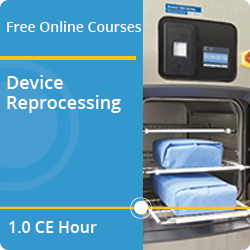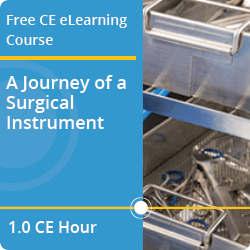Knowledge Center
February 14, 2020
What is Medical Device Reprocessing?
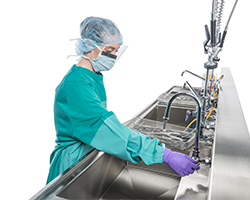
What Medical Devices Can Be Reprocessed?
Reusable medical devices like endoscopes, forceps and stethoscopes can be reprocessed. Depending on the classification of the device, reprocessing may include point-of-use treatment, cleaning, packaging, high level disinfection and sterilization, among other steps.
According to the Centers for Disease Control (CDC), disinfection and sterilization are essential to ensuring that medical devices and instruments do not transmit infectious pathogens to patients.1 Following industry guidelines and best practices for medical device reprocessing helps to reduce the risk of infection and improve patient outcomes in a healthcare facility.
Guidelines For Medical Device Reprocessing
Guidelines around medical device reprocessing come from industry governing bodies as well as the device manufacturers' Instructions for Use (IFUs) and the healthcare facility’s policies and procedures. The Spaulding classification is a representative system used for sorting medical devices into a reprocessing criticality category based on use risk. It can be used to help determine the level of processing necessary for an instrument.
| Device Type | Description |
| Non-Critical Devices | Devices that contact intact skin but not mucous membranes |
| Semi-Critical Devices | Devices that encounter mucous membranes or non-intact skin |
| Critical Devices | Devices that enter sterile tissue or the vascular system |
Non-Critical Medical Device Reprocessing
Non-critical devices include those that contact intact skin but not mucous membranes. Examples of non-critical medical devices include stethoscopes, blood pressure cuffs, and stretchers. Devices in this category must be cleaned, and if shared between patients, low- or intermediate-level disinfected.
Semi-Critical Medical Device Reprocessing
Semi-critical devices may encounter mucous membranes or non-intact skin during a procedure. Examples of semi-critical medical devices include cystoscopes, anesthesia equipment, laryngoscopes and some endoscopes. Semi-critical devices should be free from microorganisms, but small numbers of bacterial spores may remain.3 Semi-critical devices must be cleaned, and sterilization is recommended. High-level disinfection is acceptable for devices unable to be sterilized.
Critical Medical Device Reprocessing
Critical devices enter sterile areas of the body, including contact with the vascular system. Examples of critical medical devices include surgical forceps, scalpels, implants, biopsy instruments and urinary catheters. Critical devices require cleaning followed by sterilization. Common methods of sterilization include steam sterilization, vaporized hydrogen peroxide sterilization, and liquid chemical sterilization.
How Are Critical Medical Devices Reprocessed?
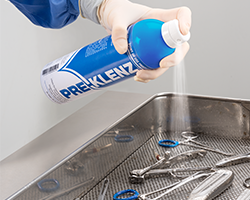
- Point-of-Use Treatment – Instrument cleaning begins at point of use following a surgical procedure. At the point of use, reusable, single-use disposable, and waste items should be separated, including the separation of sharps placed in a puncture-resistant container.2 Soils should be prevented from drying on instruments before transport is completed. Instrument transport spray gel or foam may keep instruments moist for up to 72 hours without causing damage to instruments.
- Cleaning – Cleaning is the next step in surgical instrument reprocessing. Cleaning is the removal of visible and non-visible soil and other foreign materials from medical devices being reprocessed. Disinfection and sterilization cannot be achieved until the instrument is thoroughly cleaned.
- Inspection – After an instrument is cleaned and prior to packaging, it generally goes through an inspection process, both to verify cleanliness and to detect any defects or necessary repairs or replacements.

- Packaging – Once an instrument has been cleaned, it is prepared and packaged for sterilization. Instrument wraps, trays and pouches may be used for packaging.
- Sterilization – Instruments can be sterilized once they are clean. The most commonly used methods of sterilization include steam sterilization and low temperature sterilization such as vaporized hydrogen peroxide sterilization.
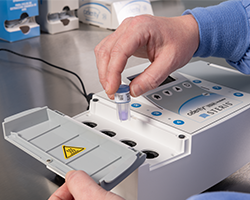
- Sterility Assurance Monitoring – Sterility assurance monitoring provides assurance that an instrument was subjected to a cycle that met the cycle parameters validated for the sterility assurance product. Sterility assurance monitoring verifies that the sterilization cycle performed met the intended sterilization parameters. Some sterility assurance products include biological indicators, chemical indicators, Bowie-Dick tests and reusable test packs.
Benefits of Reprocessing Medical Equipment
To ensure patient and staff safety as well as stay compliant, reprocessing medical devices is a necessary practice when the device or instrument is reusable. Reprocessing a device offer economic benefits for the healthcare facility, as the alternative is purchasing disposable instruments or devices for use during only a single patient procedure. While other costs are associated with medical device reprocessing (device repair and replacement, cleaning chemistries, capital purchases like sinks, washer/disinfectors, sterilizers, etc.), reprocessing through a third party or within the hospital has economic benefits for the facility.
Challenges of Reprocessing Medical Equipment
Challenges may arise when enforcing a reprocessing procedure within a healthcare facility. Ensuring the facility is following regulations and guidelines from governing bodies such as the Association for the Advancement of Medical Instrumentation (AAMI) is vital to promoting patient and staff safety and remaining complaint. More importantly, each step of the reprocessing cycle must be done carefully and thoroughly to reduce the risk of patient infection (Healthcare-Associated Infection) or injury. Following hospital procedures, industry standards and best practices, and the original equipment manufacturers' (OEM) Instructions for Use (IFU) all play an important role in a hospital’s reprocessing program.
Related STERIS University Courses
References
1 CDC Guideline to Disinfection and Sterilization in Healthcare Facilities, 2008
2 ANSI/AAMI ST79:2017, 6.2 p. 33
3 https://www.cdc.gov/infectioncontrol/guidelines/disinfection/rational-approach.html
Knowledge Center Category List
| FOLLOW US | |
|---|---|
|
|
|
|
|
|
|
|
|
|
|
|

